How To Make Bbq Pork Buns
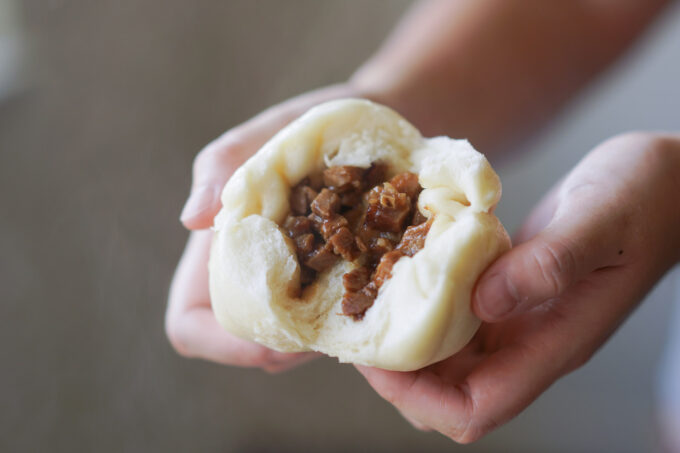
Fluffy steamed buns filled with a savory, and slightly sugariness and oozing char siu pork filling–it'due south everything y'all would want from char siu bao and brings dorsum memories of my dad buying these piddling pieces of sky for me as a kid along with the Filipino version, siopao asado.
These steamed pork buns are not but a pop dim sum favorite, but they're also dandy for making ahead of fourth dimension, freezing, and reheating them in the microwave when you demand an on the get snack! This recipe gives y'all pace by step instructions on how to do this at dwelling house.
Making the dough
Char siu bao is a blazon of baozi (which are filled buns) that are steamed with a fluffy and soft white outer layer. Its dough is very similar dough to steamed bao buns (or lotus leafage buns). Baozi is not to be confused with mantou, which are non-filled steamed buns. This bao wrapper is the first step to creating these delicious buns!
Before yous first anything, y'all want to sift the all purpose flour, cornstarch, and baking powder together to brand certain you take no lumps when forming the dough. Place the mixture directly into a stand up mixer with the dough hook attachment and add together the sugar and instant active yeast. Since I'yard using instant yeast, I don't have to wait to bloom the yeast. To test if your yeast is still good, follow this process from Rex Arthur Flour.
Plough the stand up mixer to low and gradually add the water and vegetable oil to the bowl equally the dough hook mixes the ingredients. Continue to mix on low until all the ingredients are combined and the dough pulls abroad from the sides. Mix for virtually eight minutes total or until the dough is polish. If your dough is too wet and is not pulling into a round shape in the mixer, add one tablespoon of all purpose flour at a time until y'all get the correct consistency.
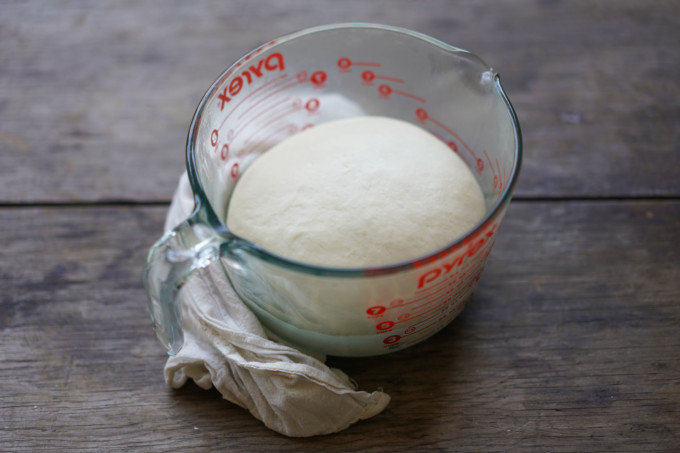
One time your dough is overnice and smooth, remove it from the bowl and shape it into a ball. Lightly grease the inside of your mixing bowl with most one teaspoon of neutral oil and then information technology doesn't stick and identify the dough back in and encompass with a damp towel. Place the dough to proof near a warm (at least 75 °F) windowsill for at least two hours.
How to make the char siu filling
To make the char siu filling, showtime, y'all need to get your hands on char siu, which is Chinese roasted pork that you tin observe at your local Chinese restaurant or even grocery store. For this recipe, we made char siu from scratch using my recipe.
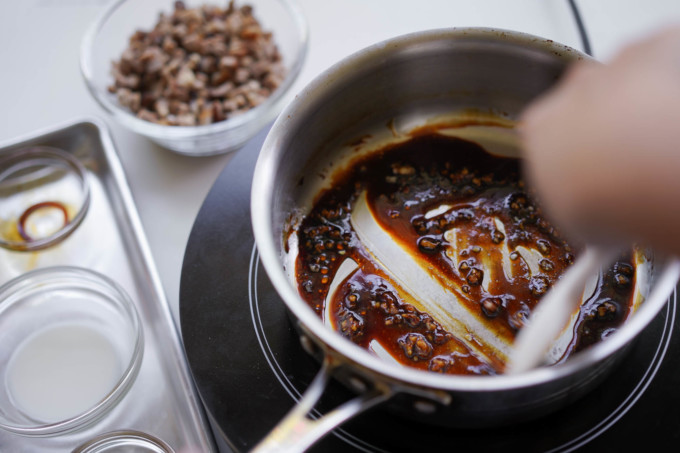
Making the filling is super easy! Chop your char siu into small-scale pieces, near 3 millimeters cubes per piece. In a saucepan over medium-high oestrus, combine the oyster sauce, lite soy sauce, dark soy sauce, sugar, v-spice, garlic, and sesame oil. Add together the cornstarch and water mixture to the bucket. When it reaches a boil, lower the heat to medium and proceed to cook for about two minutes or until the sauce is the same consistency as honey.
And so, add the char siu pieces and melt for i minute. Note: this filling shouldn't be too liquidy. Remove the filling from the oestrus and get out this to residuum while you finish making the bao buns. Yous desire to chill the sauce earlier adding them into the dough because yous'll finish up with a gummy mess if it's not cooled properly.
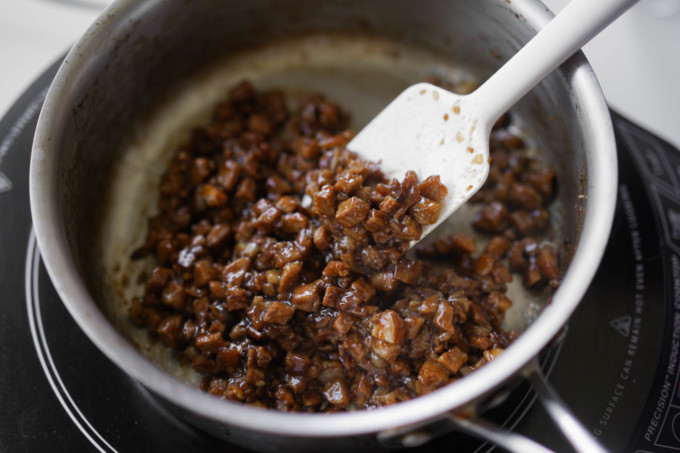
How to gather and wrap the buns
At present that you accept your sweet char siu filling, you can end making your buns! After two hours of proofing, your dough should be at least double the size information technology was previously. Remove it from the bowl and place it onto a floured surface.
Knead your dough using the heel of your hand for near 1 minute until your dough is smooth, shape it into a circle, and and so counterbalance your dough. I like to weigh my dough and separate by 24 so I can cut and shape each piece evenly. Each of my pieces are roughly 60-62 grams per slice.
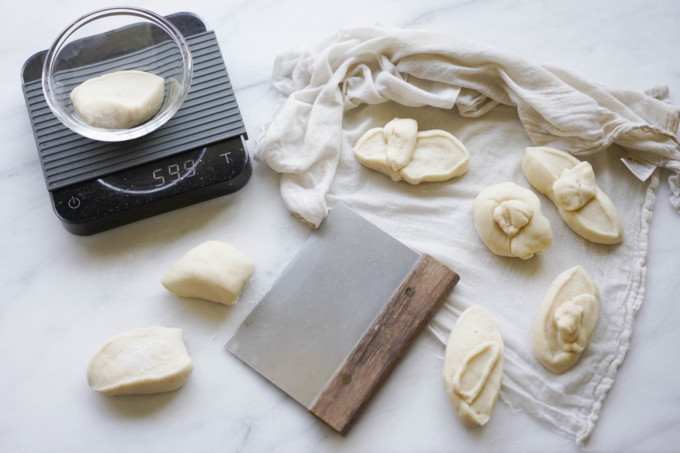
Use your hands to shape the dough into most a 3 inch thick log. Cutting one piece of dough and weigh it to make sure it's evenly proportioned. Using a rolling pin on a floured surface, take 1 piece of dough and curlicue it into about a 3 inch bore circle.
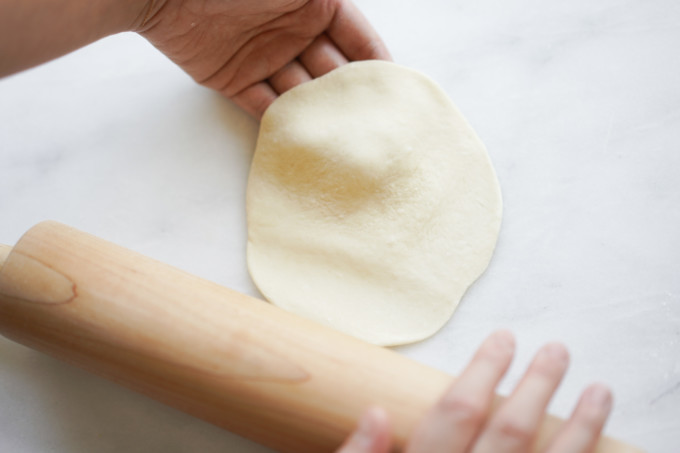
Then, roll out the edges of the circle and then that the edges are thinner than the middle section. The thin edges help with pleating the bao, and so you lot have an even amount of dough higher up and below the filling. Repeat this with the other cut pieces and log of dough.
While there are different ways to fold your bao, I like to brand a swirl on tiptop because it's more than pleasing to the eye! It definitely takes a scrap of practice, but once y'all go the hang of it, it'due south easier to exercise. Place your wrapper in the palm of your non-ascendant hand (mine is my left) and put nigh two tablespoons of char siu filling in the middle.
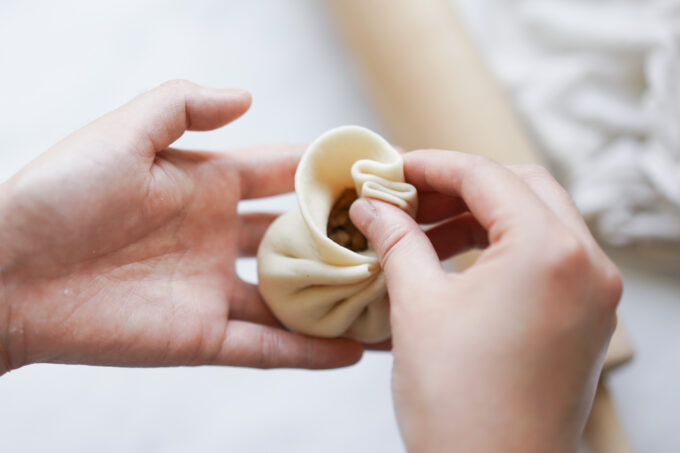
With your dominant hand, begin to fold the outside edges of the dough with your arrow finger and thumb. This should start to expect like pleating around the filling. Yous can use the index finger and pointer finger of your not-dominant hand to guide more dough into the pleating.
Continue to pleat in a circle until you reach your first fold and so close your dough by pinching–you may take to reshape it a bit to maintain the swirl design. Repeat with the residual of the baos.
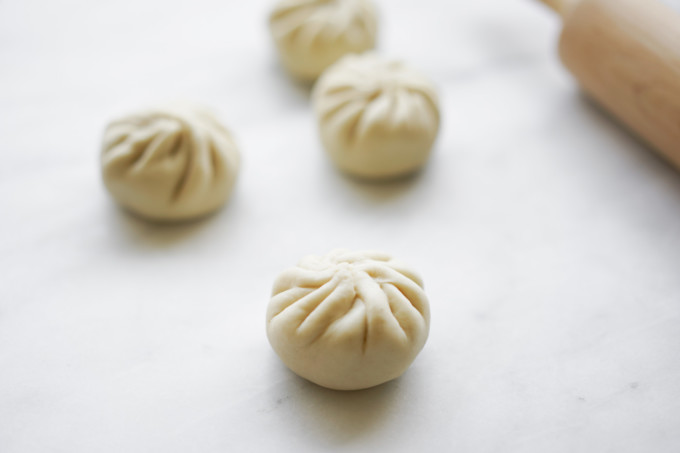
Afterward you lot've finished wrapping all your baos, cover them with a damp towel and let them proof once more than for about 10 to fifteen minutes. This gets your baos overnice and plump before steaming!
How to steam the buns
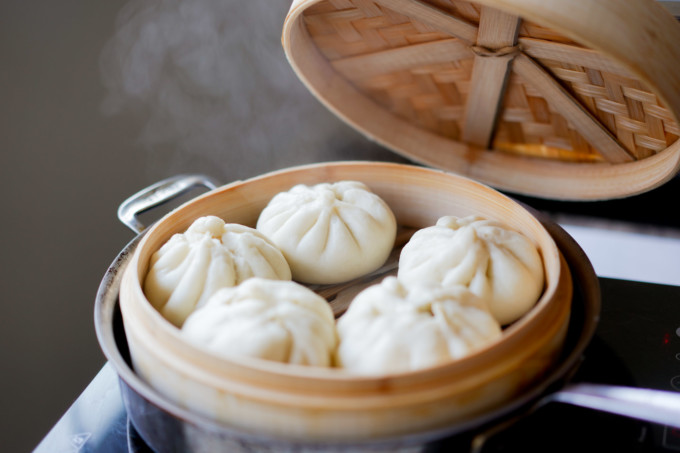
Line your steamer with parchment newspaper or even lettuce to make certain the bao does not stick to the steamer and get damaged. Fill your pot with almost one and a half inches of water (you want to make sure that the water is non touching your steamer) and place your steamer on elevation to preheat the steamer before adding in your bao.
Follow these guidelines for steaming your bao:
- Preheat your steamer for proper cooking timing. I cook the bao for well-nigh ten minutes per session and this results in fluffy and soft bao.
- Brand sure you exit space in between each bao because they will grow a bit within the steamer. I leave about 1 inch in between each bao.
- Bank check the water levels of your pot as information technology steams, and be set to add more than when it drops because y'all don't want to lose steam when cooking. Information technology's also helpful not to use a non-stick pot in case you do lose heat and ruin the coating on your pan.
- It might seem tempting, but effort not to open the lid while cooking the bao. This could change the way the buns cook and you end up losing steam.
Servings and freezing
Serve these little babies every bit shortly as possible to get an ample amount of fluffy goodness. If you do have actress on hand, I like to freeze them in an closed container and save them for later.
I like eating bao best with other dim sum sides like craven feet, cheung fun, pork and shrimp shumai, egg tarts, Chinese broccoli and oyster sauce, and xiao long bao.
How practice you reheat steamed pork buns?
To reheat steamed pork buns, wet a paper towel where it'due south well-nigh soaking, but not dripping, and wrap the bun in the towel. Microwave in 30 2nd intervals until y'all get a warm and soft pork bun. The towel imitates a similar steaming method in the microwave and should add wet to the cold and dry bun surface.
Tips
Some tips I've learned about making char siu bao to aid you:
- Before you proof your dough, make sure to knead your dough until it's smooth and pliable. The dough should be tacky, but non sticky or overly moisture when you touch it. If you don't knead your dough enough, your bao will come out lumpy and not as fluffy when you steam it.
- Although adding vegetable oil seems weird, I found that it helped become my dough to be super plump and fluffy. Definitely don't skip out on this footstep.
- Weighing out and measuring each piece of your dough is helpful considering y'all tin can make sure all your baos are even.
- After cutting pieces of the dough for wrapping, keep them covered under a towel to make sure they don't dry out out while I am wrapping bao.
- After yous make your dough and proof it, don't wait as well long to brand your bao. Your dough volition proceed to proof considering information technology has active yeast in it. This could modify the texture of your dough when you steam it.
- Proofing the bao for a second time Afterwards wrapping them actually helped plump up my bao. I definitely recommend this step. When I skipped proofing, the bao didn't get every bit fluffy.

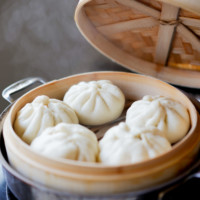
Dough
- 470 one thousand (3 ¾ c and 3 tbsp) all purpose flour
- 100 yard (12 ½ tbsp) cornstarch
- 10 g (two tsp) baking pulverization
- 6 g (ii tsp) instant active yeast
- 100 1000 (½ c) sugar
- 9 fl oz (xviii tbsp) h2o
- 2 fl oz (two tbsp) vegetable oil plus a little actress for greasing the mixing bowl
Filling
- 1 lb char siu chopped into small pieces
- ane fl oz (2 tbsp) oyster sauce
- ½ fl oz (1 tbsp) calorie-free soy sauce
- ½ fl oz (1 tbsp) night soy sauce
- 16 g (4 tsp) sugar
- .25 yard (⅛ tsp) v spice
- ii clove garlic minced
- two tsp sesame oil
- .67 g (1 tsp) cornstarch
- 2 fl oz (4 tbsp) water
Dough
-
Sift cornstarch, blistering powder, and flour together, then add to your stand mixer with the dough hook attachment. Add sugar and instant active yeast and turn the mixer onto stir.
-
Plow the stand mixer on low and slowly add the h2o and vegetable oil. Continue to mix the mixture for about viii minutes until the dough is released from the sides and is smooth.
-
Remove, accept off from the basin, shape the dough into a ball.
-
Lightly grease the inside of the mixing basin with 1 teaspoon of neutral oil and place the dough back into the basin. Cover with a damp towel and leave it to proof for at least ii hours near a warm windowsill.
Filling
-
Chop your char siu into small pieces nigh three millimeters.
-
In a saucepan, add the oyster sauce, light soy sauce, night soy sauce, sugar, five spice, garlic, and sesame oil and mix thoroughly. Cook this on medium-high heat.
-
Mix the cornstarch and h2o in a separate basin and add into the saucepan. When the mixture reaches a eddy, lower to medium heat and go along to cook for some other two minutes or until the consistency is similar to molasses.
-
Add the char siu pieces to the pan and cook for an additional minute.
-
Remove the char siu filling from the heat and permit it to rest on the counter.
Assembly and steaming
-
After two hours of proofing, your dough should have doubled in size. Motion the dough onto a floured surface and lightly knead the dough with the heel of your paw for about 1 minute until it's polish and shape into a ball.
-
Weigh the dough and carve up that weight by sixteen, for our dough, we averaged about threescore-62 grams per slice. Shape the dough into a log and apply a knife to cut pieces of dough and so weigh them to make sure all the pieces are near the same weight.
-
Take i piece and use a rolling pivot to roll it out into a three inch diameter circle. If necessarily, sprinkle flour on the surface to prevent sticking. And then, utilize your rolling pin to thin out the edges of the circle while keeping the middle section the same thickness. Your dough should be the size of about 3 ½ to 4 inches now.
-
Add two tablespoons of char siu filling in the center of the circumvolve.
-
To fold, hold your wrapper filled with meat on your not-ascendant hand. With your dominant hand, take your pollex and pointer finger and begin to fold the edges effectually the meat. This should look like pleating. I like to apply my not-dominant hand's arrow and index finger to guide more dough into the pleating. Proceed to pleat in a circle until you reach the first pleat and close off the entire summit with a pinch. The bao should have a swirl pattern on the meridian. Echo with the residual of the baos.
-
Before steaming, encompass the wrapped bao with the same damp material from before and proof again for nigh ten to 15 minutes.
-
Line your steamer with parchment paper or lettuce.
-
Add about one and a half inches of h2o in your pot, but not too much that it's touching your steamer. Preheat your steamer earlier adding the bao for about ii minutes.
-
Add your bao into the steamer and get out space between each bao.
-
Steam the bao for nearly ten minutes and practise non remove the chapeau during this time.
-
After they're finished, remove the bao from the steamer and serve immediately.
You lot can freeze the cooked bao once information technology has cooled, in an airtight container. To reheat frozen bao, wet a newspaper towel and embrace the bao. Microwave the bao in thirty 2d intervals until the bao is fluffy and hot.
Calories: 224.half dozen kcal | Carbohydrates: 33.5 yard | Poly peptide: 9.seven g | Fat: 5.5 one thousand | Saturated Fat: 3.3 yard | Cholesterol: 17.9 mg | Sodium: 206.viii mg | Potassium: 143.iv mg | Cobweb: 0.nine yard | Sugar: iv.iii g | Vitamin C: 0.1 mg | Calcium: 43.ix mg | Iron: 1.7 mg
Course: Titbit
Cuisine: Chinese
Keyword: char siu bao, steamed dumpling
Like this recipe? Subscribe to my newsletter!
![]()
Source: https://www.hungryhuy.com/char-siu-bao/
Posted by: larsenbahe1943.blogspot.com


0 Response to "How To Make Bbq Pork Buns"
Post a Comment